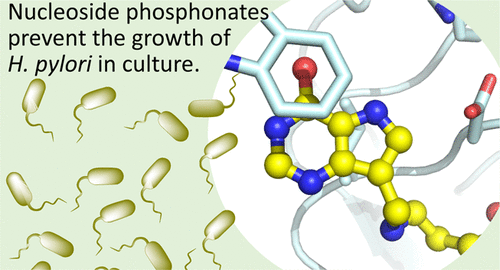当前位置:
X-MOL 学术
›
J. Med. Chem.
›
论文详情
Our official English website, www.x-mol.net, welcomes your
feedback! (Note: you will need to create a separate account there.)
Helicobacter pylori Xanthine–Guanine–Hypoxanthine Phosphoribosyltransferase—A Putative Target for Drug Discovery against Gastrointestinal Tract Infections
Journal of Medicinal Chemistry ( IF 6.8 ) Pub Date : 2021-04-23 , DOI: 10.1021/acs.jmedchem.0c02184
Dianne T. Keough 1 , Shun Jie Wun 1 , Ondřej Baszczyňski 2 , Wai Soon Eng 1 , Petr Špaček 2 , Santosh Panjikar 3, 4 , Lieve Naesens 5 , Radek Pohl 2 , Dominik Rejman 2 , Dana Hocková 2 , Richard L. Ferrero 6, 7, 8 , Luke W. Guddat 1
Journal of Medicinal Chemistry ( IF 6.8 ) Pub Date : 2021-04-23 , DOI: 10.1021/acs.jmedchem.0c02184
Dianne T. Keough 1 , Shun Jie Wun 1 , Ondřej Baszczyňski 2 , Wai Soon Eng 1 , Petr Špaček 2 , Santosh Panjikar 3, 4 , Lieve Naesens 5 , Radek Pohl 2 , Dominik Rejman 2 , Dana Hocková 2 , Richard L. Ferrero 6, 7, 8 , Luke W. Guddat 1
Affiliation

|
Helicobacter pylori (Hp) is a human pathogen that lives in the gastric mucosa of approximately 50% of the world’s population causing gastritis, peptic ulcers, and gastric cancer. An increase in resistance to current drugs has sparked the search for new Hp drug targets and therapeutics. One target is the disruption of nucleic acid production, which can be achieved by impeding the synthesis of 6-oxopurine nucleoside monophosphates, the precursors of DNA and RNA. These metabolites are synthesized by Hp xanthine–guanine–hypoxanthine phosphoribosyltransferase (XGHPRT). Here, nucleoside phosphonates have been evaluated, which inhibit the activity of this enzyme with Ki values as low as 200 nM. The prodrugs of these compounds arrest the growth of Hp at a concentration of 50 μM in cell-based assays. The kinetic properties of HpXGHPRT have been determined together with its X-ray crystal structure in the absence and presence of 9-[(N-3-phosphonopropyl)-aminomethyl-9-deazahypoxanthine, providing a basis for new antibiotic development.
中文翻译:

幽门螺杆菌黄嘌呤–鸟嘌呤–次黄嘌呤磷酸核糖基转移酶-胃肠道感染药物发现的潜在靶点
幽门螺杆菌(Hp)是一种人类病原体,生活在全球约50%的胃黏膜中,引起胃炎,消化性溃疡和胃癌。对当前药物的抵抗力的增加引发了对新的Hp药物靶标和治疗剂的寻找。一个目标是破坏核酸的产生,这可以通过阻止6-氧代嘌呤核苷单磷酸(DNA和RNA的前体)的合成来实现。这些代谢物是由Hp黄嘌呤–鸟嘌呤–次黄嘌呤磷酸核糖基转移酶(XGHPRT)合成的。在这里,已经评估了核苷膦酸酯,其抑制了该酶在K i中的活性。值低至200 nM。这些化合物的前药在基于细胞的测定中以50μM的浓度阻止Hp的生长。HpXGHPRT的动力学性质及其X射线晶体结构已在不存在和存在9-[(N -3-膦酰基丙基)-氨基甲基-9-脱氮杂黄嘌呤的情况下确定了,为新的抗生素开发提供了基础。
更新日期:2021-05-13
中文翻译:

幽门螺杆菌黄嘌呤–鸟嘌呤–次黄嘌呤磷酸核糖基转移酶-胃肠道感染药物发现的潜在靶点
幽门螺杆菌(Hp)是一种人类病原体,生活在全球约50%的胃黏膜中,引起胃炎,消化性溃疡和胃癌。对当前药物的抵抗力的增加引发了对新的Hp药物靶标和治疗剂的寻找。一个目标是破坏核酸的产生,这可以通过阻止6-氧代嘌呤核苷单磷酸(DNA和RNA的前体)的合成来实现。这些代谢物是由Hp黄嘌呤–鸟嘌呤–次黄嘌呤磷酸核糖基转移酶(XGHPRT)合成的。在这里,已经评估了核苷膦酸酯,其抑制了该酶在K i中的活性。值低至200 nM。这些化合物的前药在基于细胞的测定中以50μM的浓度阻止Hp的生长。HpXGHPRT的动力学性质及其X射线晶体结构已在不存在和存在9-[(N -3-膦酰基丙基)-氨基甲基-9-脱氮杂黄嘌呤的情况下确定了,为新的抗生素开发提供了基础。































 京公网安备 11010802027423号
京公网安备 11010802027423号